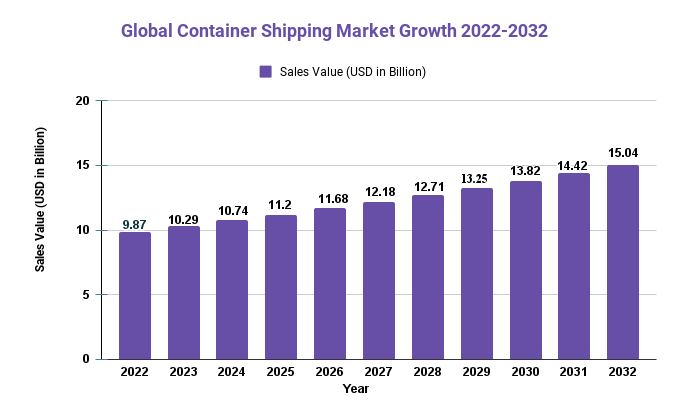Container Shipping Market Value [15.04 bn], Patent/Trademark Analysis and Growth [4.3%] by 2032
![Container Shipping Market Value [15.04 bn], Patent/Trademark Analysis and Growth [4.3%] by 2032](https://www.enterpriseappstoday.com/wp-content/uploads/2023/03/Container-Shipping-Market.jpg)
Page Contents
Market Overview
Container shipping, also known as containerized transportation, is the practice of transporting cargo using pre-configured shipping containers.
Here is an overview of the size of this market:
Market.us reported that the global container shipping market was valued at USD 9.87 billion in 2022 and is forecast to reach USD 15.04 billion by 2032, growing at a compound annual growth rate (CAGR) of 4.3% from 2022-2032.
The Asia-Pacific region dominates the container shipping market due to major manufacturing countries like China, Japan, and South Korea which generate considerable demand for container shipping services. North America and Europe are also significant markets in terms of container shipping due to their increased reliance on imported goods and commodities.
Container shipping is highly competitive, with several large global shipping companies dominating the sector, such as A.P. Moller-Maersk, Mediterranean Shipping Company (MSC), CMA CGM, Hapag-Lloyd, and COSCO Shipping. These firms compete based on factors such as service quality, pricing, and route network.
Factors fueling the container shipping market include rising global trade volumes, growing consumer goods demand, and the rising adoption of containerization for the transportation of goods. However, there are also challenges such as volatile fuel prices, regulatory compliance, and geopolitical risks which could negatively affect trade flows and demand for container shipping services.
We Have Recent Updates on the Market in Sample Copy@ https://market.us/report/container-shipping-market/request-sample
Key Takeaway
- The main takeaway from the container shipping market is its highly competitive nature and crucial role in global commerce.
- Although the market is dominated largely by global shipping companies, there are still opportunities for small players to enter niche markets.
- Due to the presence of major manufacturing countries in the region, Asia-Pacific is the largest market area for container shipping. North America and Europe are significant markets that are driven by import demand.
- Due to rising global trade volumes and the adoption of containerization to transport goods, the container shipping market will continue to grow.
- The industry faces many challenges, including volatile fuel prices, regulatory compliance, and geopolitical risk that could impact demand and profitability.

Regional Snapshot
- Asia-Pacific: The Asia-Pacific region is the leading market for container shipping, buoyed by major manufacturing countries like China, Japan, and South Korea that generate significant demand. Furthermore, this region boasts major shipping companies like A.P. Moller-Maersk and Mediterranean Shipping Company (MSC).
- North America: The North American container shipping market is highly sought-after due to the increasing demand for imported goods from Asia and Europe. Major ports in this region include Los Angeles, Long Beach, and New York-New Jersey. The market is dominated by major shipping companies such as Maersk, CMA CGM, and Hapag-Lloyd.
- Europe: Europe is a major player in container shipping, with major ports such as Rotterdam, Antwerp, and Hamburg. Here you'll find major shipping companies such as Maersk and Mediterranean Shipping Company (MSC). The demand for goods from Asia and the Middle East fuels this sector of the market.
- Middle East and Africa: The container shipping market in the Middle East and Africa is expanding due to rising trade volumes and infrastructure investments. Regional shipping companies such as Emirates Shipping Line and Gulf Navigation dominate this space.
- Latin America: The container shipping market in Latin America is driven by demand for exports of commodities such as oil, minerals, and agricultural products. Major players in this market include Maersk, CMA CGM, and Hapag-Lloyd.
Market Dynamics
Drivers
- Increased Global Trade Volumes: The container shipping market's expansion is closely connected to global trade volumes. As these continue to rise, so too does the demand for container shipping services.
- Growing Demand for Consumer Goods: As the global population grows and living standards improve, there is an escalating need for consumer items like electronics, clothing, and food. Container shipping plays a significant role in getting these essential commodities to market.
- Adoption of Containerization: Containerization has become a key driver in the container shipping market, making it more efficient, reliable, and cost-effective to move goods.
- Infrastructure Investments: The container shipping market is also affected by infrastructure investments, such as port expansions, intermodal transportation networks, and technology solutions that promote efficiency.
- The emergence of New Markets: The container shipping market is being driven by the opening up of new markets, particularly in Asia and Africa where rapid economic development is fuelling demand for consumer goods and industrial inputs.
Restraints
- Volatile Fuel Prices: The container shipping industry is heavily dependent on oil prices, which can fluctuate and impact the profitability of shipping companies. Increases in fuel costs lead to higher operating expenses which could negatively affect profitability.
- Regulatory Compliant Container Shipping Industry: Container shipping businesses must abide by a variety of regulations, such as environmental rules, safety protocols, and customs laws. Adhering to these guidelines can prove expensive and time-consuming for operators.
- Geopolitical Risks: The container shipping industry is exposed to geopolitical risks like trade disputes, political instability, and piracy. These incidents could impact demand for container shipping services as well as raise operational costs.
- Overcapacity: The container shipping industry has experienced periods of overcapacity when there are more ships available than there is demand for their services. This can result in lower freight rates and diminish profitability.
- Competition: The container shipping market is highly competitive, with a few major global shipping companies dominating it. Smaller firms may find it difficult to compete on price or services, which could limit their growth prospects.
Opportunities
- Digitalization: The container shipping industry is poised for a radical digital transformation. By adopting technologies like blockchain, big data analytics, and automation, shipping companies can boost operational efficiency, reduce costs and enhance customer service.
- E-Commerce: The growth of e-commerce has created an appetite for faster and more efficient delivery of goods, giving container shipping companies a chance to capitalize on this trend. Shippers can benefit by providing reliable shipping services with the increased speed at reduced costs.
- Emerging Markets: The container shipping market is benefitting from the expansion of emerging markets, particularly in Asia and Africa. As these economies continue to develop, demand for container shipping services is expected to rise accordingly.
- Environmental Sustainability: Customers and regulators alike are increasingly demanding environmentally friendly transportation solutions. The container shipping industry can benefit from this trend by investing in cleaner and more efficient shipping technologies.
- Infrastructure Development: The container shipping industry can benefit from the expansion of infrastructure such as ports, intermodal transportation networks, and logistics hubs by increasing operations and improving efficiency.
View Detailed TOC of the Report: https://market.us/report/container-shipping-market/table-of-content/
Challenges
- Trade Tensions: The container shipping market is highly dependent on global trade, and trade conflicts between major economies such as the US and China could negatively impact demand for container shipping services.
- Supply chain Disruptions: The COVID-19 pandemic has highlighted the vulnerability of global supply chains to disruptions such as border closures, quarantine measures, and supply shortages. These issues could affect demand for container shipping services and raise operational costs.
- Sustainability: The container shipping industry is under intense pressure to reduce its environmental footprint. Shipping companies must reduce emissions, invest in cleaner technologies and employ sustainable business practices.
- Cybersecurity: The container shipping industry is vulnerable to cyber attacks that can disrupt operational efficiency, disrupt supply chains and cause financial losses.
- Oversupply of Vessels: The container shipping industry has experienced periods of oversupply, where there are more ships available than there is demand for container shipping services. This can lead to a decrease in freight rates and negatively affect profitability.
Key Market Segments
Type
- Dry Containers (Standard and Special)
- Reefer Containers
- Tanks
Application
- Automotive
- Metal
- Machinery
- Others
Key Market Players
- APM-Maersk
- CMA CGM
- COSCO Container Lines
- Evergreen Line
- Mediterranean Shipping
- APL
- China Shipping
- Hamburg Sud
- Hanjin Shipping
- Hapag-Lloyd
- Mitsui O.S.K Lines
- NYK Line
- Orient Overseas Container Line
Report Scope
| Report Attribute | Details |
| The market size value in 2022 | USD 9.87 Bn |
| Revenue forecast by 2032 | USD 15.04 Bn |
| Growth Rate | CAGR Of 4.3% |
| Regions Covered | North America, Europe, Asia Pacific, Latin America, and Middle East & Africa, and Rest of the World |
| Historical Years | 2017-2022 |
| Base Year | 2022 |
| Estimated Year | 2023 |
| Short-Term Projection Year | 2028 |
| Long-Term Projected Year | 2032 |
Frequently Asked Question
Q: What is the current market size for the Global Container Shipping Market?
A: According to a report by Market.us, the Global Container Shipping Market was valued at USD 9.87 billion in 2022 and is expected to reach USD 15.04 billion by 2032, growing at a CAGR of 4.3% during the forecast period.
Q: What are the key segments of the Global Container Shipping Market?
A: The Global Container Shipping Market can be segmented based on type (Dry Containers (Standard and Special), Reefer Containers, Tanks), Application (Automotive, Metal, Machinery, Others), and geography (North America, Europe, Asia-Pacific, Latin America, and Middle East & Africa).
Q: Who are the key players in the Global Container Shipping Market?
A: Some of the key players in the Global Container Shipping Market include APM-Maersk, CMA CGM, COSCO Container Lines, Evergreen Line, Mediterranean Shipping, APL, China Shipping, Hamburg Sud, Hanjin Shipping, Hapag-Lloyd, Mitsui O.S.K Lines, NYK Line, Orient Overseas Container Line.
The team behind market.us, marketresearch.biz, market.biz and more. Our purpose is to keep our customers ahead of the game with regard to the markets. They may fluctuate up or down, but we will help you to stay ahead of the curve in these market fluctuations. Our consistent growth and ability to deliver in-depth analyses and market insight has engaged genuine market players. They have faith in us to offer the data and information they require to make balanced and decisive marketing decisions.



